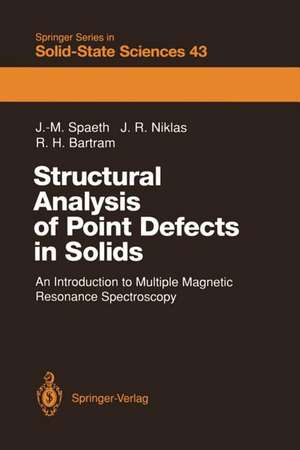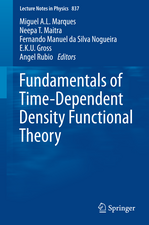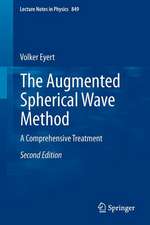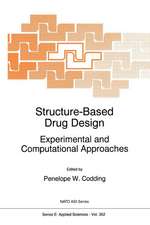Structural Analysis of Point Defects in Solids: An Introduction to Multiple Magnetic Resonance Spectroscopy: Springer Series in Solid-State Sciences, cartea 43
Autor Johann-Martin Spaeth, Jürgen R. Niklas, Ralph H. Bartramen Limba Engleză Paperback – 11 ian 2012
Din seria Springer Series in Solid-State Sciences
- 18%
 Preț: 1216.88 lei
Preț: 1216.88 lei -
 Preț: 642.45 lei
Preț: 642.45 lei - 18%
 Preț: 1010.11 lei
Preț: 1010.11 lei - 15%
 Preț: 528.15 lei
Preț: 528.15 lei -
 Preț: 541.46 lei
Preț: 541.46 lei - 18%
 Preț: 955.26 lei
Preț: 955.26 lei -
 Preț: 383.01 lei
Preț: 383.01 lei - 18%
 Preț: 1813.98 lei
Preț: 1813.98 lei - 15%
 Preț: 656.13 lei
Preț: 656.13 lei -
 Preț: 387.01 lei
Preț: 387.01 lei - 15%
 Preț: 634.88 lei
Preț: 634.88 lei - 15%
 Preț: 630.47 lei
Preț: 630.47 lei - 18%
 Preț: 889.60 lei
Preț: 889.60 lei - 15%
 Preț: 643.15 lei
Preț: 643.15 lei - 15%
 Preț: 646.56 lei
Preț: 646.56 lei - 18%
 Preț: 883.66 lei
Preț: 883.66 lei - 15%
 Preț: 635.85 lei
Preț: 635.85 lei - 15%
 Preț: 644.75 lei
Preț: 644.75 lei - 15%
 Preț: 640.86 lei
Preț: 640.86 lei - 15%
 Preț: 639.57 lei
Preț: 639.57 lei - 15%
 Preț: 648.98 lei
Preț: 648.98 lei - 18%
 Preț: 949.62 lei
Preț: 949.62 lei - 15%
 Preț: 632.91 lei
Preț: 632.91 lei - 23%
 Preț: 1043.41 lei
Preț: 1043.41 lei - 15%
 Preț: 634.38 lei
Preț: 634.38 lei - 15%
 Preț: 643.46 lei
Preț: 643.46 lei - 15%
 Preț: 632.77 lei
Preț: 632.77 lei - 15%
 Preț: 635.34 lei
Preț: 635.34 lei -
 Preț: 388.52 lei
Preț: 388.52 lei -
 Preț: 387.99 lei
Preț: 387.99 lei - 15%
 Preț: 633.87 lei
Preț: 633.87 lei - 18%
 Preț: 998.64 lei
Preț: 998.64 lei - 18%
 Preț: 725.40 lei
Preț: 725.40 lei - 15%
 Preț: 635.67 lei
Preț: 635.67 lei - 15%
 Preț: 638.93 lei
Preț: 638.93 lei - 18%
 Preț: 1221.92 lei
Preț: 1221.92 lei - 18%
 Preț: 943.20 lei
Preț: 943.20 lei - 15%
 Preț: 637.96 lei
Preț: 637.96 lei - 15%
 Preț: 635.85 lei
Preț: 635.85 lei - 18%
 Preț: 1220.03 lei
Preț: 1220.03 lei
Preț: 390.46 lei
Nou
Puncte Express: 586
Preț estimativ în valută:
74.78€ • 77.05$ • 62.64£
74.78€ • 77.05$ • 62.64£
Carte tipărită la comandă
Livrare economică 24 februarie-10 martie
Preluare comenzi: 021 569.72.76
Specificații
ISBN-13: 9783642844072
ISBN-10: 3642844073
Pagini: 384
Ilustrații: XI, 367 p.
Dimensiuni: 155 x 235 x 20 mm
Greutate: 0.54 kg
Ediția:Softcover reprint of the original 1st ed. 1992
Editura: Springer Berlin, Heidelberg
Colecția Springer
Seria Springer Series in Solid-State Sciences
Locul publicării:Berlin, Heidelberg, Germany
ISBN-10: 3642844073
Pagini: 384
Ilustrații: XI, 367 p.
Dimensiuni: 155 x 235 x 20 mm
Greutate: 0.54 kg
Ediția:Softcover reprint of the original 1st ed. 1992
Editura: Springer Berlin, Heidelberg
Colecția Springer
Seria Springer Series in Solid-State Sciences
Locul publicării:Berlin, Heidelberg, Germany
Public țintă
ResearchCuprins
1. Introduction.- 1.1 Structure of Point Defects.- 1.2 Basic Concepts of Defect Structure Determination by Electron Paramagnetic Resonance.- 1.3 Superhyperfine and Electronic Structures of Defects in Solids.- 2. Fundamentals of Electron Paramagnetic Resonance.- 2.1 Magnetic Properties of Electrons and Nuclei.- 2.2 Electrons and Nuclei in an External Magnetic Field.- 2.3 Some Useful Relations for Angular Momentum Operators.- 2.4 Time Dependence of Angular Momentum Operators and Macroscopic Magnetization.- 2.5 Basic Magnetic Resonance Experiment.- 2.6 Spin-Lattice Relaxation.- 2.7 Rate Equations for a Two-Level System.- 2.8 Bloch Equations.- 2.9 Conventional Detection of Electron Paramagnetic Resonance and Its Sensitivity.- 3. Electron Paramagnetic Resonance Spectra.- 3.1 Spin Hamiltonian.- 3.2 Electron Zeeman Interaction.- 3.3 g-Factor Splitting of EPR Spectra.- 3.4 Fine-Structure Splitting of EPR Spectra.- 3.5 Hyperfine Splitting of EPR Spectra.- 3.6 Superhyperfine Splitting of EPR Spectra.- 3.7 Inhomogeneous Line Widths of EPR lines.- 4. Optical Detection of Electron Paramagnetic Resonance.- 4.1 Optical Transitions of Defects in Solids.- 4.2 Spectral Form of Optical Transitions of Defects in Solids.- 4.3 EPR Detected with Magnetic Circular Dichroism of Absorption Method.- 4.4 MCDA Excitation Spectra of ODEPR Lines (MCDA “Tagged” by EPR).- 4.5 Spatially Resolved MCDA and ODEPR Spectra.- 4.6 Measurement of Spin-Lattice Relaxation Time T1 with MCDA Method 105.- 4.7 Determination of Spin State with MCDA Method.- 4.8 EPR of Ground and Excited States Detected with Optical Pumping.- 4.9 EPR Optically Detected in Donor-Acceptor Pair Recombination Luminescence.- 4.10 Optically Detected EPR of Triplet States.- 4.11 ODEPR of Trapped Excitons with MCDA Method.- 4.12Sensitivity of ODEPR Measurements.- 5. Electron Nuclear Double Resonance.- 5.1 The Resolution Problem, a Simple Model.- 5.2 Type of Information from EPR and NMR Spectra.- 5.3 Indirect Detection of NMR, Double Resonance.- 5.4 Examples of ENDOR Spectra.- 5.5 Relations Between EPR and ENDOR Spectra, ENDOR-Induced EPR.- 5.6 Electron Nuclear Nuclear Triple Resonance (Double ENDOR).- 5.7 Temperature Dependence and Photo-Excitation of ENDOR Spectra.- 6. Determination of Defect Symmetries from ENDOR Angular Dependences.- 6.1 Definition of Neighbor Shells.- 6.2 Neighbor Shells and Transformation of Interaction Tensors.- 6.3 Interaction Tensor Symmetries and ENDOR Angular Dependence.- 6.4 Neighbor Shell Symmetries and ENDOR Angular Dependences.- 6.5 Low Symmetry Defects in Higher Symmetry Environments.- 6.6 Ways to Distinguish Between High and Low Symmetry Defects.- 6.7 Role of EPR Spectrum for an ENDOR Analysis.- 6.8 Solution of the Spin Hamiltonian.- 6.9 Software Treatment of ENDOR Spectra.- 7. Theoretical Interpretation of Superhyperfine and Quadrupole Interactions.- 7.1 Structures of Point Defects.- 7.2 Origin of Zeeman, Hyperfine and Quadrupole Interactions.- 7.3 Central Ion Hyperfine Structure.- 7.4 Covalency and Superhyperfine Interaction.- 7.5 Orthogonalized Envelope Functions.- 7.6 Simple Approximations and Illustrations for Interpretation of shf and Quadrupole Interactions.- 8. Technology of ENDOR Spectrometers.- 8.1 Experimental Constraints for Conventional ENDOR.- 8.2 ENDOR Spectrometer Design.- 8.3 Components of ENDOR Spectrometer.- 9. Experimental Aspects of Optically Detected EPR and ENDOR.- 9.1 Sensitivity Considerations.- 9.2 ODMR Spectrometers Monitoring Light Emission.- 9.3 ODMR Spectrometers Monitoring Magnetic Circular Properties of Absorption and Emission.-9.4 Experimental Details of the Components of an MCDA/MCPE ODMR Spectrometer.- Appendices.- B. The Cayley Transformation Formula.- C. Algorithm for the Subtraction of an Unknown Background.- D. Digital Filters for Application in ENDOR Spectra.- E. Deconvolution of ENDOR Spectra.- F. Peak Search Algorithm.- G. Simulation of EPR Spectra.- References.













